Digital Posters
Breast: DWI, AI & Emerging Techniques
ISMRM & SMRT Annual Meeting • 15-20 May 2021

| Concurrent 7 | 13:00 - 14:00 |
1113.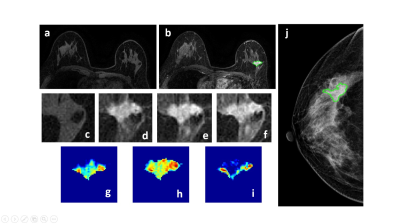 |
Diagnosis of Breast Cancer Using Radiomics Models Built Based on DCE-MRI and Mammography Compared to BI-RADS Reading
Zhongwei Chen1, Yang Zhang2, Jiejie Zhou1, Youfan Zhao1, Haiwei Miao1, Huiru Liu1, Shuxin Ye1, Nina Xu1, Meihao Wang1, and Min-Ying Su2
1Department of Radiology, The First Affiliated Hospital of Wenzhou Medical University, wenzhou, China, 2Department of Radiological Sciences, University of California, Irvine, CA, United States
A total of 200 patients receiving both DCE-MRI and mammography were analyzed, including 146 malignant and 56 benign lesions. For each lesion, 3D tumor mask was done using fuzzy-C-means clustering algorithm. Three DCE parametric maps were generated, and the radiomics features were extracted from these maps by PyRadiomics. Five models were built based on DCE-MRI, mammography, and the combination. The BI-RADS score was obtained from the radiology reports for comparison. The model built based on all MRI and mammography features yielded the highest accuracy of 89.6%, and had significantly better diagnostic performance than BI-RADS using threshold of 4A or 4B.
|
|||
1114.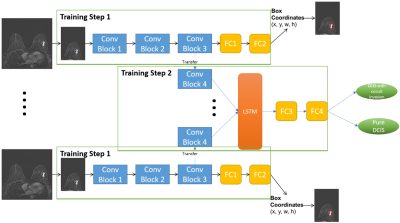 |
Predicting Underestimation of Invasive Cancer in Patients with Core-needle Biopsy-diagnosed Ductal Carcinoma in Situ using Deep Learning
Luu-Ngoc Do1, Chae Yeong Im2, Jae Hyuk Park2, So Yeon Ki3, Ilwoo Park2,4,5, and Hyo Soon Lim2,3
1Department of Radiology, Chonnam National University, Gwangju, Korea, Republic of, 2College of Medicine, Chonnam National University, Gwangju, Korea, Republic of, 3Department of Radiology, Chonnam National University Hwasun Hospital, Hwasun, Korea, Republic of, 4Department of Artificial Intelligence Convergence, Chonnam National University, Gwangju, Korea, Republic of, 5Department of Radiology, Chonnam National University Hospital, Gwangju, Korea, Republic of
This study aims to explore the effectiveness of deep learning algorithms for distinguishing pure (noninvasive) ductal carcinoma in situ (DCIS) from invasive disease for patients showing DCIS in core-needle biopsy using MRI. Preoperative axial dynamic contrast-enhanced MRI data from 352 patients were used to train, validate and test the two-step convolutional neural network (CNN) utilizing a recurrent model. Our model produced an accuracy of 69.4% and AUC of 0.721. The comparison between the proposed model and a 2D or 3D model suggests that the sequential information may provide an important support for occult invasive cancer in patients diagnosed with DCIS.
|
|||
1115. |
Combination of pharmacokinetic parameters and texture features of DCE-MRI for predicting preoperative classification of breast cancer
Xia Wu1,2,3, Zhou Liu4, Meng Wang4, Zhe Ren1,2,3, Ya Ren4, Jie Wen4, Qian Yang4, Xin Liu1,2,3, Hairong Zheng1,2,3, and Na Zhang1,2,3
1Paul C. Lauterbur Research Center for Biomedical Imaging, Shenzhen Institutes of Advanced Technology, Chinese Academy of Sciences Synopsis, ShenZhen, China, 2Key Laboratory for Magnetic Resonance and Multimodality Imaging of Guangdong Province, Shenzhen Institutes of Advanced Technology, Chinese Academy of Sciences, ShenZhen, China, 3CAS key laboratory of health informatics, Shenzhen Institutes of Advanced Technology, Chinese Academy of Sciences, ShenZhen, China, 4Department of Radiology, National Cancer Center/Cancer Hospital and Shenzhen Hospital, Chinese Academy of Medical Sciences and Peking Union Medical College, ShenZhen, China
We have achieved preoperative classification of breast cancer by combination of pharmacokinetic parameters and texture features using machine learning. Using the information available in each feature space, an appropriate feature fusion method using information from the two feature spaces can help the classification process and improve diagnosis accuracy. Among them, SVM and KNN have better performance.
|
|||
1116.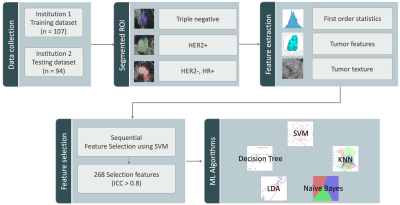 |
Classification of Breast Cancer Molecular Subtypes on DCE-MRI Using Radiomics Analysis with Various Machine Learning Algorithm
Yan-Lin Liu1, Yang Zhang1,2, Jeon-Hor Chen1,3, Siwa Chan4, Jiejie Zhou5, Meihao Wang5, and Min-Ying Su1
1Department of Radiological Sciences, University of California, Irvine, CA, United States, 2Department of Radiation Oncology, Rutgers-Cancer Institute of New Jersey, Robert Wood Johnson Medical School, New Brunswick, NJ, United States, 3Department of Radiology, E-Da Hospital and I-Shou University, Kaohsiung, Taiwan, 4Department of Medical Imaging, Taichung Tzu-Chi Hospital, Taichung, Taiwan, 5Department of Radiology, The First Affiliate Hospital of Wenzhou Medical University, Wenzhou, China
Two datasets were used, 107 cases for training and 94 cases for testing. Patients were classified into three subtypes: TN, HER2+, and (HR+/HER2-). Three heuristic DCE parametric maps were generated from DCE-MRI. PyRadiomics was applied to extract features. Five machine learning algorithms were implemented to build models. The classification accuracy in training dataset was 84.3%, 77.2%, 75.5%, 74.3%, 69.1% for SVM, Decision tree, LDA, KNN, Naïve Bayes, respectively. In binary classification for TN vs. Non-TN, accuracy was 91.0% in training and 88.2% in testing datasets. For HER2+ vs. HER2-, accuracy was 90.4% in training and 86.2% in testing datasets.
|
|||
1117.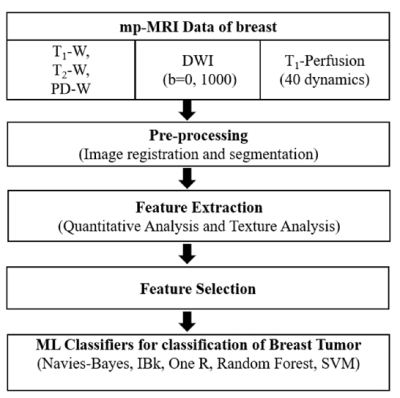 |
Characterization of Breast Tumor using Machine Learning based upon Multi-parametric MRI Features.
Snekha Thakran1, Rakesh Kumar Gupta2, and Anup Singh1,3
1Centre for Biomedical Engineering, Indian Institute of Technology Delhi, New Delhi, India, Delhi, India, 2Department of Radiology, Fortis Memorial Research Institute, Haryana, Gurgaon, India, Delhi, India, 3Department of Biomedical Engineering, All India Institute of Medical Science, New Delhi, India, Delhi, India
Multi-parametric MRI(mp-MRI) has shown promising outcomes with high sensitivity and accuracy in the characterization of breast tumor. Quantitative analysis of mp-MRI and texture features with machine learning approach have also shown potential in improving accuracy of breast tumor classification. The objective of this study was to differentiate low-grade vs. high-grade breast tumor using machine learning with optimized feature vector obtained from mp-MRI data. The study included mp-MRI data of 35 patients with breast cancer. The combination of support-vector-machine(SVM) with Wrapper method using Adaptive-Boosting(AdaBoost) technique resulted in high sensitivity(0.94±0.07), specificity(0.80±0.05), and accuracy(0.90±5.48) in classification of low-grade vs. high-grade tumors.
|
|||
| 1118. | A meta-analysis of the diagnostic performance of machine learning–based MRI for axillary lymph node metastasis in breast cancer patients
Chen Chen1, Fabao Gao1, and Xiaoyue Zhou2
1Department of Radiology, West China Hospital, Chengdu, China, 2MR Collaboration, Siemens Healthineers Ltd., Shanghai, China
Axillary lymph node dissection (ALND) is the gold standard for evaluating axillary lymph node metastasis (ALNM), but ALND may not confer a survival advantage. Therefore, reliable, noninvasive approaches for preoperative prediction of ALNM have been needed. The use of machine learning (ML) in predicting ALNM in breast cancer patients has been reported. We have conducted a large-sample-size assessment and a meta-analysis of published studies concerning the diagnostic performance of ML-based MRI in predicting ALNM in breast cancer patients.
|
|||
1119.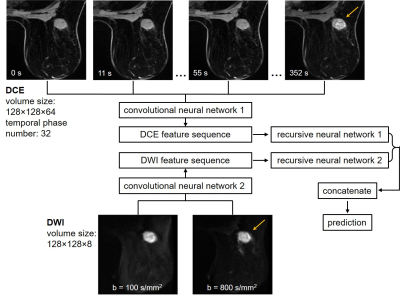 |
Early prediction of pathologic complete response to neoadjuvant systemic therapy for triple-negative breast cancer using deep learning
Zijian Zhou1, David E. Rauch1, Jong Bum Son1, Benjamin C. Musall1, Nabil A. Elshafeey2, Jason B. White3, Mark D. Pagel4, Stacy Moulder3, and Jingfei Ma1
1Imaging Physics, The University of Texas MD Anderson Cancer Center, Houston, TX, United States, 2Breast Imaging, The University of Texas MD Anderson Cancer Center, Houston, TX, United States, 3Breast Medical Oncology, The University of Texas MD Anderson Cancer Center, Houston, TX, United States, 4Cancer Systems Imaging, The University of Texas MD Anderson Cancer Center, Houston, TX, United States
Prediction of response to neoadjuvant systemic therapy for triple-negative breast cancer is important for patient management. Here we constructed a deep learning convolutional and recursive neural network ensemble for early prediction of pathologic complete response utilizing pre-treatment DCE and DWI breast MRIs. Images from 135 patients were partitioned into training/validation/testing groups with the ratio of 80/20/35. For the testing group, the network achieved an accuracy of 69%, with the sensitivity of 75% and specificity of 63%. The area under the receiver operating characteristic curve was 0.68.
|
|||
1120.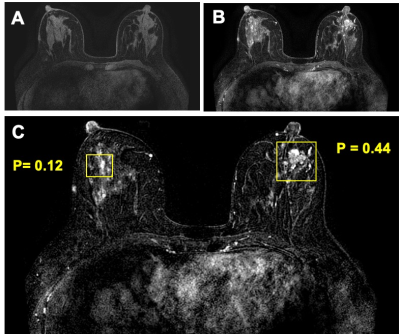 |
Application of Two Deep Learning Networks for Diagnosis of Breast Cancer on MRI: Automatic Detection Using Mask R-CNN Followed by Classification Using ResNet50
Yang Zhang1,2, Yan-Lin Liu2, Ke Nie1, Jiejie Zhou3, Siwa Chan4, Vivian Youngjean Park5, Min Jung Kim5, Zhongwei Chen3, Jeon-Hor Chen2,4, Meihao Wang3, and Min-Ying Su2
1Department of Radiation Oncology, Rutgers-Cancer Institute of New Jersey, Robert Wood Johnson Medical School, New Brunswick, NJ, United States, 2Department of Radiological Sciences, University of California, Irvine, CA, United States, 3Department of Radiology, The First Affiliate Hospital of Wenzhou Medical University, Wenzhou, China, 4Department of Medical Imaging, Taichung Tzu-Chi Hospital, Taichung, Taiwan, 5Department of Radiology and Research Institute of Radiological Science, Severance Hospital, Yonsei University College of Medicine, Seoul, Korea, Republic of
Mask R-CNN and ResNet50 were implemented to search the entire breast MRI to identify suspicious lesions, and then to further evaluate their likelihood of malignancy. The dataset included 103 malignant and 73 benign lesions in 153 patients. In detection phase using Mask R-CNN, 101 malignant, 48 benign, and 130 normal enhancing tissues were detected as suspicious. When putting them into ResNet50 for characterization, 99 cancers were correctly diagnosed as malignant, and only 16 benign lesions and 16 normal enhancing tissues remained as likely malignant. The true positive rate was 99/103=96%, and many detected false positives were dismissed during classification phase.
|
|||
1121.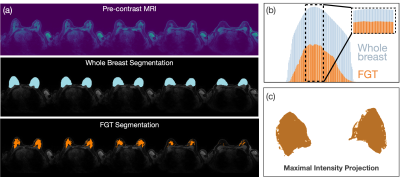 |
A Parsimonious Assessment of Breast Density Classes from Quantitative, AI-based FGT Volume Segmentations
Pablo F. Damasceno1,2, Tatiana Kelil1,2, Rutwik Shah1,2, Bruno Astuto Arouche Nunes1,2, Jason Crane1,2, and Sharmila Majumdar1,2
1Radiology and Biomedical Imaging, University of California San Francisco, San Francisco, CA, United States, 2Center for Intelligent Imaging, University of California San Francisco, San Francisco, CA, United States
Given its potential importance as a biomarker of breast cancer risk, a reliable and objective quantitative measurement of Fibroglandular tissue (FGT) with limited intra or inter-rater variability will be invaluable in clinical practice. Currently, the amount of FGT in breast MRIs is reported via a 4-level qualitative system. We investigate the relationship between these classes and the amount of FGT, obtained via deep-learning segmentations. We find that the distribution of FGT in these classes deviates significantly from quartiles, but more uniform distributions can be achieved by emulating the radiologist’s workflow during clinical reporting.
|
|||
1122.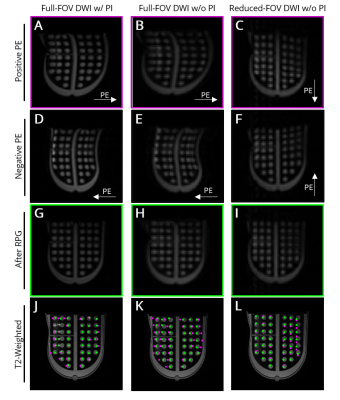 |
Correction of Artifacts Induced by B0 Inhomogeneities with RPG on a Breast Diffusion Phantom
Lauren K Fang1, Ana E Rodriguez-Soto1, Summer J Batasin2, Kathryn E Keenan3, and Rebecca A Rakow-Penner2
1Radiology, University of California San Diego, La Jolla, CA, United States, 2University of California San Diego, La Jolla, CA, United States, 3National Institute of Standards and Technology, Boulder, CO, United States
Diffusion-weighted imaging (DWI) has shown potential to diagnose and monitor breast cancer, but is limited in part due to geometric distortion artifacts that affect echo-planar imaging. Generating distortion-free images is a key step towards its clinical implementation. Here, we investigated the effectiveness of artifact-reduction data collection strategies (i.e. parallel imaging DWI and reduced field-of-view DWI) in combination with reverse polarity gradient post-processing in correcting for geometric distortion artifacts.
|
|||
1123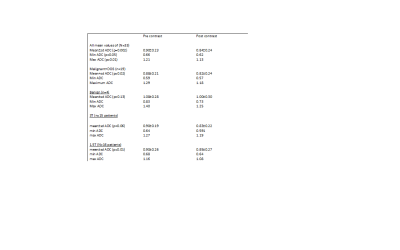 |
Influence of gadolinium-based contrast agent on DWI and ADC values in breast lesions Video Permission Withheld
Kay van der Hoogt1, Robert-Jan Schipper1, Ronni Wessels1, Cees de Graaf1, Arjan te Boekhorst1, Leon ter Beek2, Regina Beets-Tan1, and Ritse Mann1
1Radiology, the Netherlands Cancer Institute – Antoni van Leeuwenhoek, Amsterdam, Netherlands, 2Medical Physics, the Netherlands Cancer Institute – Antoni van Leeuwenhoek, Amsterdam, Netherlands It is advocated to perform breast DWI-acquisitions before contrast administration [1]. However, performing DWI after contrast MRI might be more practical in a clinical context. Several studies [2] evaluated whether performing breast MRI before or after contrast administration impacts the DWI classifying properties. However, previous research was often based on an interpatient analysis. Therefore, we performed a retrospective intra-patient analysis on perfusion-free ADC-maps before and after contrast administration. A decrease in ADC was observed in post-contrast ADC-values. This was independent of the B0-field strength, and similar for benign and malignant lesions.
|
|||
1124.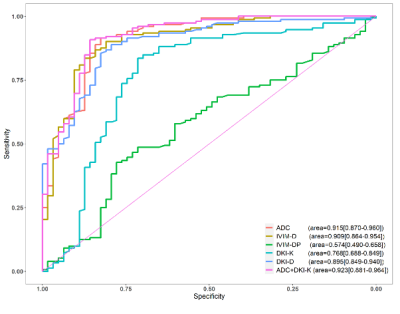 |
A Comparison of different models of diffusion-weighted MRI in distinguishing benign and malignant breast lesions
Muzhen He1, Huiping Ruan1, Mingping Ma1, Zhongshuai Zhang2, and Robert Grimm2
1Radiology, Provincial Clinical College of Fujian Medical University, Fujian Provincial Hospital, Fuzhou, China, 2Siemens Healthcare Ltd, Shanghai, China
This study aims to analyze the value of ADC, IVIM and DKI in differentiating benign and malignant breast nodules. The combination of all the quantitative diffusion parameters is also evaluated. The value of ADC, IVIM-D, KDI-K and DKI-D can be used as a diagnostic tool for evaluating benign and malignant breast lesions. Compared with IVIM-D, DKI-K and DKI-D, ADC value is the best single discriminative parameters to differentiate breast lesions. Further, the combination of ADC and DKI-K value shows the best diagnostic efficacy.
|
|||
1125.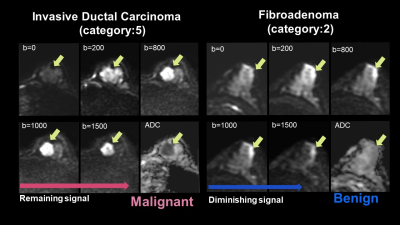 |
A BI-RADS like lexicon for Breast DWI: Proposal and early evaluation
Mami Iima1,2, Aika Okazawa3, Ryosuke Okumura3, Sachiko Takahara4, Tomotaka Noda3, Taro Nishi3, Yuji Nakamoto1, and Masako Kataoka1
1Diagnostic Imaging and Nuclear Medicine, Kyoto University Graduate School of Medicine, Kyoto, Japan, 2Clinical Innovative Medicine, Institute for Advancement of Clinical and Translational Science, Kyoto University Hospital, Kyoto, Japan, 3Radiology, Kitano Hospital, The Tazuke Kofukai Medical Research Institute, Osaka, Japan, 4Breast Surgery, Kitano Hospital, The Tazuke Kofukai Medical Research Institute, Osaka, Japan
Our proposed DWI reading method based on the BI-RADS lexicons from multiple b-value images had comparable specificity and NPV to the standard BI-RADS. The DWI reading method might increase diagnostic confidence in differentiating malignant and benign breast tumors. Excellent to substantial agreement was observed for DWI reading. Substantial-perfect agreement was observed in lesion characteristics and fibrograndular tissues, according to an adjusted BI-RADS lexicon for lesion classification. These results suggest that DWI reading methods might be applicable in a clinical setting, however, the agreement is moderate for non-mass lesions, which is still challenging for clinical application.
|
|||
1126.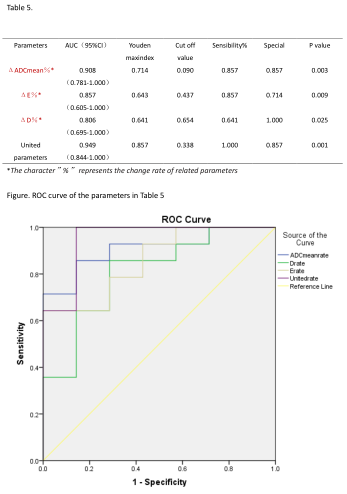 |
Evaluation of the efficacy of therapy for breast cancer using DWI and DCE-MRI based on acquired radial golden-angle compressed sensing
Haiyun Wang1, Qian Xu1, Gaofeng Shi1, Lijia Wang1, Qinglei Shi2, and Chen Zhang2
1CTMRI, The Fourth Hospital of Hebei Medical University, Shijiazhuang,Hebei, China, 2MR Scientific Marketing,Siemens Healthcar, Beijing, China
In this study, we studied the feasibility of GRASP based DCE technique and readout-segmented DWI technique in early prediction and evaluation of breast cancer response to neoadjuvant chemotherapy. We found the combination of these two techniques demonstrated great potential in evaluating the response of breast cancer to neoadjuvant therapy.
|
|||
1127.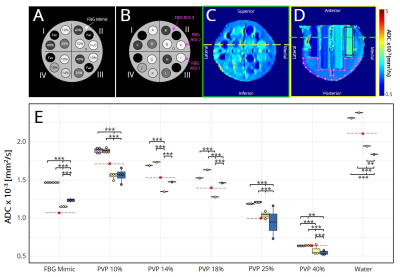 |
Accuracy and Precision of a Breast Diffusion Phantom Across 3T Scanners
Lauren K Fang1, Ana E Rodríguez-Soto1, Kathryn E Keenan2, and Rebecca A Rakow-Penner1
1Radiology, University of California San Diego, La Jolla, CA, United States, 2National Institute of Standards and Technology, Boulder, CO, United States
Diffusion-weighted imaging (DWI) has shown potential to diagnose and monitor breast cancer by differentiating benign and malignant lesions. Malignancy-specific cutoff values for DWI estimates have been difficult to establish due to variability across scanners and imaging sites. Thus, understanding the accuracy and precision of these quantitative methods may inform clinical implementation of DW-MRI. Here, we investigated the accuracy and precision of ADC values within a breast phantom across four 3T MRI scanners by the same vendor.
|
|||
1128.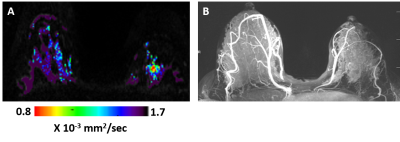 |
Evaluation of Lactating Breasts Using Diffusion Tensor Magnetic Resonance Imaging: A Feasibility Study.
Anabel M Scaranelo1, Hadassa Degani2, Dov Grobgeld3, Vivianne Freitas1, Shelley Westergard4, Christine Elser5, and Edna Furman-Haran3
1Medical Imaging, University of Toronto, Toronto, ON, Canada, 2DDE MRI Solutions Ltd., Tel Aviv, Israel, 3Weizmann Institute of Science, Rehovot, Israel, 4Princess Margaret Cancer Center, Toronto, ON, Canada, 5University of Toronto, Toronto, ON, Canada
The performance of breast DTI in the diagnosis of breast cancer in high-risk lactating patients as compared to DCE imaging was prospectively assessed. The study included 38 patients of which six were diagnosed with breast cancer. All six cancers were detected by DTI and showed significantly lower diffusion coefficients and lower anisotropy in comparison to contralateral normal breast tissue. Sensitivity, specificity and accuracy were respectively, 100%, 93.2%, 93.8% for DTI and 66.7%, 83.8% and 82.5% for DCE. The results showed the potential of breast DTI as an aid in the diagnostic workup of high-risk women during the lactation period.
|
|||
1129.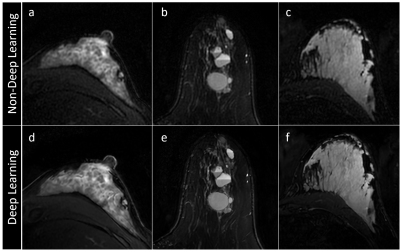 |
Feasibility of Using a Deep Learning Reconstruction to Increase Protocol Flexibility for Breast MRI
Timothy Allen1,2, Leah C Henze Bancroft2, Lloyd Estkowski3, Ty A Cashen3, Frederick Kelcz2, Frank R Korosec1,2, Roberta M Strigel1,2,4, Orhan Unal1,2, and James H Holmes2
1Medical Physics, University of Wisconsin-Madison, Madison, WI, United States, 2Radiology, University of Wisconsin-Madison, Madison, WI, United States, 3Global MR Applications and Workflow, GE Healthcare, Madison, WI, United States, 4Carbone Cancer Center, University of Wisconsin-Madison, Madison, WI, United States
A deep learning reconstruction was evaluated for use in T2w breast MRI. Breast radiologists scored deep learning (DL) images significantly higher than non-DL images in four categories: artifacts, perceived signal-to-noise ratio, sharpness, and overall quality. DL was then used to improve the quality of high-resolution T2w breast series acquired in clinically-acceptable scan times. High resolution protocols typically require compromise between scan time and image quality. However, implementation of a deep learning reconstruction allowed for shorter scan times while maintaining diagnostic image quality. A deep learning reconstruction could allow for a clinically-feasible, high-resolution T2w acquisition.
|
|||
1130.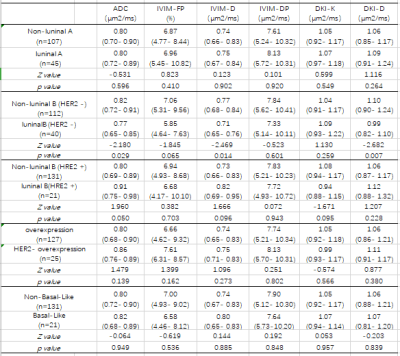 |
Quantitative evaluation of different models of diffusion-weighted MRI for the correlation with molecular subtype of breast cancer
Muzhen He1, Huiping Ruan1, Mingping Ma2, Zhongshuai Zhang3, and Robert Grimm3
1Radiology, Provincial Clinical College of Fujian Medical University, Fujian Provincial Hospital, Fuzhou, China, 2Provincial Clinical College of Fujian Medical University, Fujian Provincial Hospital, Fuzhou, China, 3Siemens Healthcare Ltd, Shanghai, China
This study aimed to compare the performance of different diffusion models of,including the mono-exponential, intravoxel incoherent motion (IVIM) model and the diffusion kurtosis imaging (DKI) model,for the correlation with molecular subtype and molecular prognostic factors. The results indicate that ADC, IVIM-D, DKI-D can be used to differentiate luninal B group from others molecular subtype. Quantitative MR diffusion parameters, such as ADC ,DKI-K, DKI-D , IVIM-FP and IVIM-D were significantly associated with HER2 overexpression, Ki-67 proliferation status and histological grade in patients with breast cancer.
|
|||
1131. |
Differentiating breast adenosis and breast cancer lesions: Value of Synthetic MRI
Peiying Zhu1, Xiaoan Zhang1, Lin Lu1, Xin Zhao1, Qingna Xing1, Yafei Guo1, Kaiyu Wang2, Jinxia Guo2, Xueyuan Wang1, and Penghua Zhang1
1Department of Radiology, The Third Affiliated Hospital of Zhengzhou University, Zhengzhou, China, zhengzhou, China, 2GE Healthcare, MR Research China, Beijing, China, zhengzhou, China
Synthetic MRI is able to obtain various image comtrasts and quantitative parameters.These parameters( T1, T2, and PD values) directly reflect the composition of the tissue.The objective of this study was to assess Synthetic magnetic resonance imaging (MRI) ability for differentiation between breast adenosis and breast cancer.Our results show that show that Synthetic MRI is a useful tool that can be utilised to discriminate between breast adenosis and breast cancer.
|
|||
1132.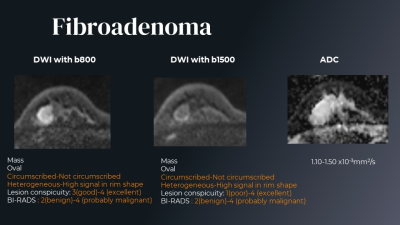 |
Clinical utility of breast DWI in the assessments of breast lesions using different b values
Mami Iima1,2, Maya Honda1, Rie Ota1, Masako Kataoka1, Masakazu Toi3, and Yuji Nakamoto1
1Diagnostic Imaging and Nuclear Medicine, Kyoto University Graduate School of Medicine, Kyoto, Japan, 2Clinical Innovative Medicine, Institute for Advancement of Clinical and Translational Science, Kyoto University Hospital, Kyoto, Japan, 3Breast Surgery, Kyoto University Graduate School of Medicine, Kyoto, Japan
We have 1) assessed the clinical utility of DWI in the diagnosis of breast lesions using DW-based BI-RADS lexicons and lesion conspicuity and 2) investigated the diagnostic performance of breast lesions based on DW-based BI-RADS category by 3 radiologists using breast DW images with b=800 or b=1500 s/mm2. Agreement in DW-based BI-RADS categories tended to be higher in b1500 compared to b800 DW images. Diagnostic performance based on b800 and b1500 DW images was not uniform among 3 readers, which highlight the necessity and importance of the standardization on reading protocols and experience from DWI readers.
|
The International Society for Magnetic Resonance in Medicine is accredited by the Accreditation Council for Continuing Medical Education to provide continuing medical education for physicians.